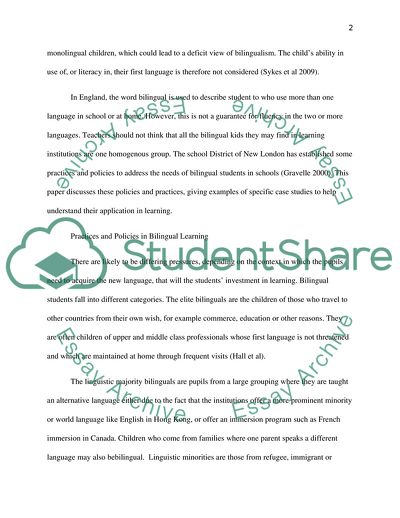Cite this document
(Bilinguals Learning in the School District of New London - Policies and Practices Case Study Example | Topics and Well Written Essays - 4250 words, n.d.)
Bilinguals Learning in the School District of New London - Policies and Practices Case Study Example | Topics and Well Written Essays - 4250 words. https://studentshare.org/english/1791946-describe-and-critically-review-the-policy-and-practice-demonstrated-in-one-school-or-service-towards-bilingual-learners-providing-brief-case-studies-to-support-your-analysis-on-the-basis-of-this-review-make-recommendations-for-changes-to-the-approach-a
Bilinguals Learning in the School District of New London - Policies and Practices Case Study Example | Topics and Well Written Essays - 4250 words. https://studentshare.org/english/1791946-describe-and-critically-review-the-policy-and-practice-demonstrated-in-one-school-or-service-towards-bilingual-learners-providing-brief-case-studies-to-support-your-analysis-on-the-basis-of-this-review-make-recommendations-for-changes-to-the-approach-a
(Bilinguals Learning in the School District of New London - Policies and Practices Case Study Example | Topics and Well Written Essays - 4250 Words)
Bilinguals Learning in the School District of New London - Policies and Practices Case Study Example | Topics and Well Written Essays - 4250 Words. https://studentshare.org/english/1791946-describe-and-critically-review-the-policy-and-practice-demonstrated-in-one-school-or-service-towards-bilingual-learners-providing-brief-case-studies-to-support-your-analysis-on-the-basis-of-this-review-make-recommendations-for-changes-to-the-approach-a.
Bilinguals Learning in the School District of New London - Policies and Practices Case Study Example | Topics and Well Written Essays - 4250 Words. https://studentshare.org/english/1791946-describe-and-critically-review-the-policy-and-practice-demonstrated-in-one-school-or-service-towards-bilingual-learners-providing-brief-case-studies-to-support-your-analysis-on-the-basis-of-this-review-make-recommendations-for-changes-to-the-approach-a.
“Bilinguals Learning in the School District of New London - Policies and Practices Case Study Example | Topics and Well Written Essays - 4250 Words”. https://studentshare.org/english/1791946-describe-and-critically-review-the-policy-and-practice-demonstrated-in-one-school-or-service-towards-bilingual-learners-providing-brief-case-studies-to-support-your-analysis-on-the-basis-of-this-review-make-recommendations-for-changes-to-the-approach-a.


